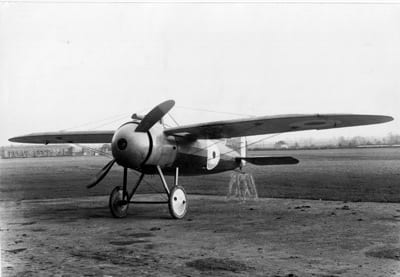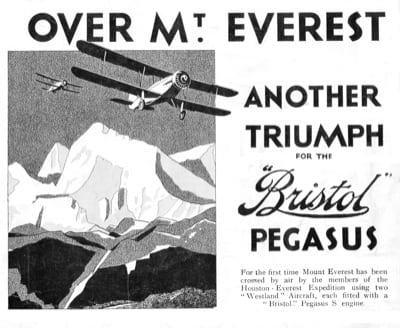April 4, 2013, marked the 80th anniversary of the successful aerial assault on Mt. Everest undertaken by two Royal Air Force pilots, David Fowler McIntyre and Douglas Douglas-Hamilton, flying modified, open-cockpit, Westland biplanes to an altitude of 30,000 feet.
It was a triumph for aviation, particularly for the skill and organization demonstrated by the British project, which prepared for months for the successful expedition.
This installment of Flight and Flyers will not only recount the Everest flight, but take a look at earlier aerial adventures that saw mountain ranges conquered by air.
FIRST OVER THE ALPS – 1910
In 1910 the Italian Society of Aviation offered a $20,000 prize to the pilot who could successfully fly from Brig, Switzerland, over the Simplon Pass of the Alps to Milan, Italy.
“Aviators must fly above a mountain region filled with jagged peaks, dazzling snowscapes, precipices of all kinds, making a landing utterly impossible,” reported Scientific American, which added that “managing the apparatus increases immensely with the ascent, for the wind currents are very violent and capricious, rapidly varying in direction and intensity.”
One of the 11 entrants for the prize was George Chavez, a 23-year-old Paris-born aviator with less than a year’s flying experience. After several tries thwarted by strong winds, on Chavez, satisfied with the weather conditions, started from Brig in his Bleriot on Sept. 23.

He reached a height of more than 7,000 feet and soared over the pass. After having covered one-third of the distance to his destination, the wind overturned his machine when he attempted a landing to take on fuel before continuing on to Milan. After 40 minutes of flying time he had crossed the Alps over the route that had taken Napoleon two weeks to cross.
Though he did not complete the flight as planned, the Italian society awarded him $10,000 in recognition of the first crossing of the Alps by air. Unfortunately Chavez was severely injured by the crash and died a few days later.
Although l9l0 was a red-letter year in flying achievement, with aviators of several nations chalking up new records for distance and time, Chavez’s flight was the climax of the year and called “The most daring feat in all aviation.”
ROCKIES 1911
The first excursion over mountains in the United States that gained wide attention was Cromwell Dixon’s flight over the Rockies in September 1911. Dixon, who was only licensed by the Aero Club of America on Aug. 31 was, at 18 years old, billed as the “World’s Youngest Aeronaut.”
A student of Glenn Curtiss, he was a member of the Curtiss Exhibition Team and in great demand for aviation events.
On Sept. 30, Dixon’s last day of performing at the Montana State Fair, he took off for a flight over the Rockies hoping to win a prize offered for such a flight by the State Fair. The path of the flight was from Helena, Montana, to Blossburg in the mountains and return.
Dixon took off from Helena at 2 p.m. and easily arrived at Blossburg. Departing at 3:16 he ran into strong winds that poured over the mountains and hampered his climb to altitude. He finally gained enough altitude and headed back to Helena, arriving at 3:59.
He crossed the Rockies at Mullan Pass, which has an elevation of 6,200 feet. He made the cross country flight at an altitude of 7,100 feet. Dixon covered the total distance of more than 50 miles on the round-trip and was gone from the fair grounds for an hour and 50 minutes.
On his return a purse of $10,000 was presented to him. His fame for the flight not only spread across the states, but reached Europe as well.
Unfortunately his glory would not last long, as a few days later during a flight at Spokane, Washington, he was caught by an adverse air current and plunged into a rocky railroad cut, receiving injuries that caused his death.
OVER THE ANDES
Although aviation had been introduced to South America by 1910, the Andes Mountains remained a barrier to air commerce until 1918. With World War I over in Europe, the British supplied Chile with a number of surplus aircraft, including six Bristol monoplanes with powerful 110-hp engines. The British also sent along an RAF pilot for instruction in the aircraft.
One of the Chilean pilots was Lt. Dagoberto Godoy, who earlier in 1918 had been denied permission to try a flight over the Andes in a Morane-Saulnier. He asked the British instructor if the Bristol was fit for the task and after being told it was capable of such a flight, began training in the Bristol and planning the mountain flight.

Early in the morning of Dec. 12, 1918, Godoy was ready with his single-seat, 110-hp Bristol fighter facing eastward toward a row of 20,000-foot mountains only 60 miles away. At 4:20 am he started his craft, left Santiago, flew over the Tupunagto range at an altitude of 19,700 feet and landed near Mendoza, Argentina, a little more than two hours later. The first flight had been made over the Andes. The flight was an occasion for celebration in Chile and the pilot became a national hero.
THE FINAL FRONTIER
A flight over Mt. Everest, the world’s highest mountain, had been envisioned for many years. In March 1918 a paper was presented to the Royal Aeronautical Society on the possibilities of aerial reconnaissance of the Himalaya.
In September 1918, when Army Capt. Rudolph “Shorty”Schroeder set a world’s record of 28,900 feet, Aerial Age magazine remarked that the record was only 102 feet short of the highest mountain peak in the world. However, it would be another 15 years before an aerial expedition of the mountains would be mounted.
In 1932 a group from the RAF started working on a flight over Everest. The objective was “to make an important contribution to geography and to its allied sciences.”
The flight would be the most treacherous mountain flight yet attempted. Existing aircraft engines would not work in the thin air at 30,000 feet, even if fuel could be developed that did not freeze. Breathing apparatus, necessary at high altitudes, was still unreliable. Above all, the unpredictable winds over the Himalayas would make any flight hazardous.

In February 1933, the Houston Mount Everest Flying Expedition headed by Air Commodore P F M Fellowes left for India. The expedition’s two Westland Wallace biplane aircraft had powerful new turbocharged Pegasus engines, improved fuels, and sophisticated cameras. During tests in England the aircraft had successfully flown to 35,000 feet.
On April 3, 1933, the two open-cockpit British biplanes flown by David Fowler McIntyre and Douglas Douglas-Hamilton took off from Purnea, India, 134 miles from Mt. Everest. The flight to Everest and return was made in about three hours. To reach the peak of the mountain the pilots climbed their planes to an altitude of 30,000 feet. They made two complete circuits of the peak and returned to base.
Unfortunately the flight failed to obtain a photo of the summit when the photographer blacked out due to a ruptured oxygen line. The flight was successfully repeated on April 19.
The flights made the pilots world famous. Douglas-Hamiliton, the lead pilot, was decorated with the Air Cross in 1935. In 1935 the two pilots would form the aircraft manufacturing company Scottish Aviation. A documentary film of their adventure, Wings Over Everest, won a Hollywood Oscar in 1936.
These early achievements in mountain flying attracted press attention comparable with the early space age, and was indicative of an interest in high altitude flying that would emerge later in pressurized passenger aircraft “flying above the weather.”

Great article. Very interesting. I enjoyed learning something about the early years of aviation.